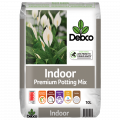Most premium and specialty potting mixes that carry the Australian Standard Red Tick, especially those formulated for indoor plants should include a controlled release fertiliser that will release nutrients to feed plants for several months at a time – usually between three and six months.
The front panel of our Scotts Osmocote and Debco premium potting mix bags include a series of thumbnails, which tell you what is in each of the mixes as well as how long it will feed your indoor plants for.
While an indoor plant potting mix that includes a fertiliser will provide the basics after potting, your indoor plants will respond well to a bit more love and attention.
When to fertilise indoor plants
Additional feeding every two to four weeks will keep your indoor plants lush and, if they flower, blooming freely. An indoor plant liquid or water soluble fertiliser is the best way to go as nutrients are immediately available and readily absorbed.
We’ve made it really easy for you with Scotts Osmocote Pour & Feed Indoor Plant Fertiliser. There’s no need to dilute or mix up concentrates in a watering can. It’s ready to go! Using the “easy pour” measuring cap, there’s no mess or drips. Formulated for all indoor and container plants, it contains a balanced blend of nutrients and growth stimulants so that you will see visible results in 7 days.
About six months after purchase or repotting indoor plants, when the fertilisers in the potting mix are exhausted, add a fresh dose of controlled release fertiliser following the application rates and instructions on the tub. We use and recommend Scotts Osmocote Contolled Release Fertiliser for Pots, Planters & Indoors or Scotts Osmocote for Potted Plants.
The fertiliser beads (known as prills) should be spread in a circle on top of the potting mix towards the outer rim of the pot. The feeding roots will be found towards the outside of the pot so avoid feeding too close to the main stem or trunk.
Optimal indoor plant growing conditions
Indoor plants enjoy optimum growing conditions year-round, thanks to ducted heating and/or air conditioning. However, many will still have a period over the winter months when they don’t need fertilising quite as often.
The lower intensity of natural light over the cooler season slows down indoor plant growth, which results in lower demand for both nutrients and moisture. During this period, stretch out the interval between liquid fertilising indoor plants to four to six weeks.










